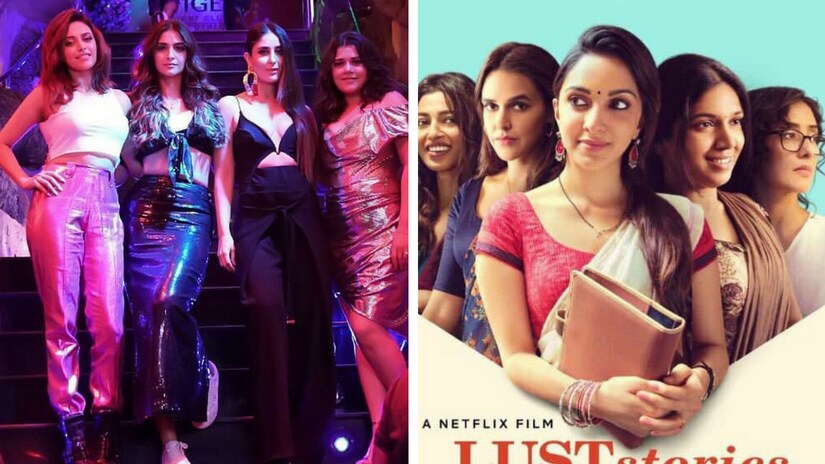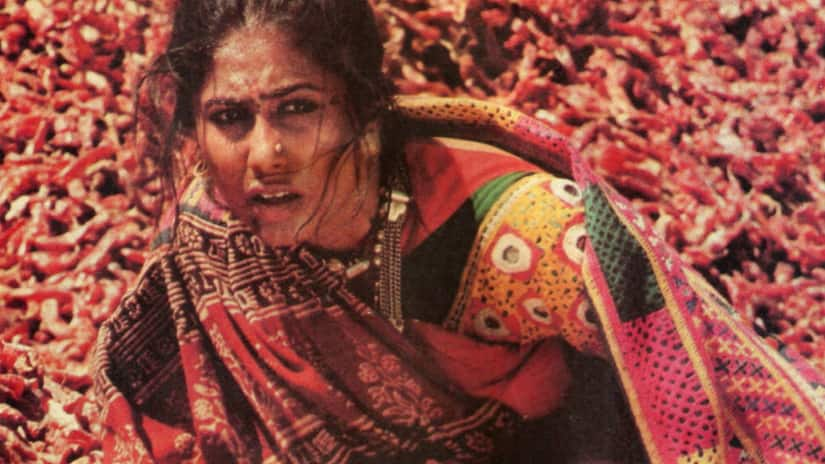The year 2018 has brought in a definite change in Hindi cinema and its portrayal of a woman’s sexuality. It’s now parked firmly in the mainstream, the choice of a woman to pleasure herself. Karan Johar’s story in the anthology _Lust Stories_ , Anurag Kashyap’s confused married woman in the same film, do not have morality driving them in essence. As remarks and counter remarks around _Veere Di Wedding_ continue to stoke discussions online, it’s worth remembering that a woman’s sexuality has not always been a repressed matter in mainstream Hindi or Indian cinema. Films have explored this aspect in the past, and it has been a slow process of evolution that has equipped filmmakers today to show masturbation without compromise. Each time, such films have sparked conversations. _Read: Lust Stories: Netflix's anthology is a between-the-sheets reading of conflicts that arise outside the bedroom_ [caption id=“attachment_4641251” align=“alignnone” width=“825”]  Posters of Veere Di Wedding, Lust Stories (Facebook)[/caption] In 2000, Mahesh Manjrekar delivered the powerful Astitva, starring Tabu. The film has a housewife, the mother of an adult son, arguing with her husband that seeking sexual satisfaction, given that he travelled constantly for work and was never around, was not wrong. She is forced to explain her extramarital affair with a music teacher when family friends come visiting. One of her guests, played by Smita Jayakar, takes her side. In Astitva, Tabu’s character, Aditi, is not the sinner; she is the defender of seeking normal desires. More recently (2014), _Margarita With A Straw_ addressed this quest for sexual fulfilment by a girl that suffers from cerebral palsy. Kalki Koechlin delivered brilliantly on her part as Laila, the wheelchair-bound teenager who discovers her sexual desires. Margarita With A Straw won accolades but felt limited because of its focus on sexuality alone. Having said that, the film artfully tackled the fact that a physically challenged person can have the same needs as anyone else. Neeraj Ghaywan’s _Masaan_ also begins with a woman in Varanasi suffering from society’s judgments when the local police turn moral, barge in on her when she is with her boyfriend and brand her a prostitute. Masaan never once shows the woman as a hapless victim. On the fringes of mainstream cinema, a few more have explored facets of female sexuality. _Pink_ argued for a woman’s right to say no to sexual advances. Deepa Mehta’s Fire and Water directly addressed the conflict of social mores, family limitations against a woman’s physical desire. Fire took up lesbian love and Water touched upon love and desire that young widows, sequestered from society, experience. Both films were considered controversial, whereas they just addressed realities that prevail. _Anarkali of Aarah_ and _Parched_ deal with sexual desire and its role in shaping women’s lives in small towns and villages. In the former, a showgirl refuses sexual advances of a powerful local politician and has to face consequences; in the latter, four women in a rural setting have to travel different paths of sexual experience to solve their problems. Since the onset of the new millennium, a woman’s sexual voice has begun to find expression subtly and slowly. Films that have put the woman’s sexuality out there and made it central to a story have made an impact in the past too. In these films, women were not suffering courtesans or nautch girls; they aren’t victims, seeking to be validated as good women by society, making them stand out. [caption id=“attachment_4641281” align=“alignnone” width=“825”]  Poster of Pink (left); still from Margarita With A Straw (centre); still from Astitva. Facebook[/caption] In 1997, Aastha hit theatres. Starring Rekha, Om Puri and Daisy Irani, filmmaker Basu Bhattacharya made an honest film where a woman explores her sexuality outside of marriage and uses it to acquire material comfort. The film didn’t portray Rekha as a victim of poverty, who is forced into upper-class prostitution. Rather she is a mother who is unhappy about her inability to fulfil smaller material comforts for her daughter and herself. Her husband, played by the late Om Puri, is not seen as weak and dogmatic. Neither is their marriage shown as unhappy. Rekha’s character and the film drew huge criticism from audiences, verging on outrage. Her choice — to seek material comforts and therefore, step out of bounds of marriage — was seen as outrageous. Aastha was uncompromising and reflective of a society that had finally begun to discover materialism with the economic liberalization of 1992-93. Similarly, despite the fact that it didn’t become a super hit, Karan Johar’s Kabhi Alvida Naa Kehna had Rani Mukerji have sex with her lover in a hotel room, even as she deals with guilt, despite having a decent man for a husband. Johar’s film also sparked outrage, despite its growing relevance in present times. Johar touched upon the same subject — of a middle-aged woman connecting with her desires — in _Ae Dil Hai Mushkil_ , although he left a lot unsaid. That marriage is not an endpoint in a woman’s journey of sexual fulfilment is validated with these films, a slice of everyday reality that is always spoken about in whispered tones. Turn the clock back some more and there’s Rihaee, made in 1988, by Aruna Raje. Based in rural Gujarat, it shows three women from a village that end up having affairs with the same man, a Dubai returned worker. Touching upon the loneliness of women whose husbands leave them alone for long periods of time to seek work in cities and abroad, the film deals with sexual fulfilment where women seek out a desirable man. When two of these women find themselves pregnant, it shows inherent hypocrisy and discrimination that women face. One of Hema Malini’s best performances, and with Naseeruddin Shah, Reema Lagoo, Ila Arun amongst others Rihaee brings to fore a very real issue — of women who are sexually unsatisfied and their methods of dealing with it. In 1987, Ketan Mehta’s Mirch Masala, with the unforgettable performance by the late Smita Patil, stood out for the defiance that a woman in colonial India shows to sexual advances of a powerful man. Sonbai refuses to yield to her master’s exploitative desires, and in the process, awakens a rebellion amongst other women. [caption id=“attachment_4641271” align=“alignnone” width=“825”]  Still from Ketan Mehta’s Mirch Masala. Facebook[/caption] Utsav, by Girish Karnad, might have sunk Shashi Kapoor financially as a producer, but the film stands apart for its aesthetic and forward-thinking depiction of a courtesan’s beauty and sexuality. True to form to an ancient Indian text, Utsav doesn’t paint the central character of Vasant Sena, played by Rekha, as an evil temptress. Made in 1984, Utsav is a breakthrough film. _Also read: Veere Di Wedding: Feminism is now a buzzword, and the onus of talking about it solely rests on Bollywood's women_ As Veere Di Wedding and Lust Stories set a benchmark of sorts in putting women’s desires first, the journey of female sexuality has been gradual. It has also been slow to catch up, not in sync with India’s growing liberal, independent women. It’s easy to miss those films that sought to address female desire in the general categorization of mainstream Hindi cinema, which is reductionist. But the change has always been happening.
As Veere Di Wedding and Lust Stories set a benchmark of sorts in putting women’s desires first, the journey of female sexuality in Bollywood has been gradual
Advertisement
End of Article


)
)
)
)
)
)
)
)
)



